Abstract
The Caucasian Sea was among the vast tropical water masses that existed on Earth in the Mesozoic. The knowledge of Kimmeridgian–Hauterivian deposits from the central Western Caucasus can facilitate the understanding of the Caucasian paleogeography at the Jurassic–Cretaceous transition. Taking into account the scale of the study area and its geological complexity, a generalized synthesis of the published information seems to be an appropriate option to propose a tentative paleogeographical model. Some original field and laboratory studies, including the examination of the composition of Hauterivian alluvial sandstones, contribute to this model. Kimmeridgian–Hauterivian deposits crop out in the northern, western, and southern domains of the study area, but older rocks are exposed in its central and eastern parts. The Caucasian Sea covered the study area in the early Kimmeridgian, but a large land appeared in the late Kimmeridgian and existed until the end of the Hauterivian despite certain shoreline shifts. The land was eroded deeply, with exposure of pre-Upper Jurassic rocks, including Precambrian–Paleozoic crystalline complexes, and the sedimentary material was delivered to an alluvial plain on its periphery. The registered sea–land interplay was controlled tectonically.
1. Introduction
Vast water masses existed on Earth during the Late Jurassic–Early Cretaceous interval of geological time, and one of them was the Neotethys Ocean with its large marginal seas [1,2,3]. A typical marginal sea of this kind was the Caucasian Sea, which corresponded to the back-arc and adjacent basins that were subsequently compressed and deformed to form the present Caucasus Mountains [4,5]. This Mesozoic semi-enclosed sea was situated at the northern Neo-Tethyan margin, south of the relatively stable Russian Platform. The configuration of this sea is still poorly understood, although the related knowledge is essential to check large-distance paleo(bio)geographical connections through this water mass in the Mesozoic. This is why geological investigations revealing the position of the Caucasian Sea at the Jurassic–Cretaceous transition are required.
Previous researchers indicated that the Caucasian Sea, which existed in the Mesozoic–early Cenozoic, was not a homogeneous water mass but was divided into sectors by some land in its central part. This was either a single large island, an archipelago of islands, or a large peninsula extended from the Russian Platform [5,6,7,8,9]. The position, shape, and extent of this land are yet to be known precisely due to the highly complex regional geology, the sporadic distribution and often small size of outcrops, and the significant erosion of Mesozoic sedimentary complexes in the axial part of the Greater Caucasus. One would also add a striking separation of the previous Jurassic and Cretaceous studies in this region. Indeed, the noted difficulties should not distract from the studies and the subsequent interpretations of the Caucasian geology, although some different approaches are required.
The evidence from the previous studies [5,6,7,8,9] implies that the central Western Caucasus is a major area that is promising for studies of sea–land interplay at the Jurassic–Cretaceous transition. Particularly, Kimmeridgian–Hauterivian deposits are known in three principal domains of this area. The actual size of the latter is very large, and its rough topography and limited accessibility should also be noted. This is why advanced sedimentological analyses, detailed interpretations of depositional environments, and highly accurate paleogeographical reconstructions will require multiple research projects for many years. They cannot be comprehended by a single research project, and their results cannot be presented in a single research paper. Indeed, it would be very unreasonable to wait for the accumulation of all related lines of evidence because these may appear only after several decades (and in the case of sufficient geologists’ interest). Similarly unreasonable would be to restrict the research focus to only small parts of the central Western Caucasus because this will not permit registration of such large-scale features as possible Mesozoic islands. However, ignoring the promising research topic would be even worse because this will leave the Caucasus a “blank space” (“empty hole”) on the paleogeographical reconstructions of the northern Neo-Tethyan margin.
In the situation described above, a fresh look at the already available information seems to be better than leaving the noted “blank space”. A solution to the problem can be achieved via a synthesis of the stratigraphical and sedimentological information collected in the mid-20th century and the beginning of the 21st century, supplemented by the outcomes of novel, small-scale studies at important geological localities. Such a synthesis can be used as a basis for tentative paleogeographical reconstructions, which can further be improved after new investigations. Importantly, preparation of the demanded syntheses should be coupled with certain generalizations to minimize the influences of various minor uncertainties and inconsistencies between old and new (or simply different) literature sources.
The present work offers a synthesis and subsequent paleogeographical interpretation of the information about Kimmeridgian–Hauterivian deposits of the central Western Caucasus. In particular, attention was paid to the previous “classical” research of the mid-20th century and the newest studies carried out already in the 21st century. In this regard, the work acts as a kind of review. Nonetheless, it is supplemented by a case study of Lower Cretaceous alluvial sandstones, the outcomes of which contribute to the better understanding of the sea–land interplay. The originality of this study is determined by the novelty of the synthesis and the related interpretations, as well as by the above-mentioned case study. Indeed, this contribution, sharing the feature of review and research papers, can provide only tentative inferences. However, the latter are important to start filling the above-mentioned “blank space” in the large-scale paleogeographical interpretations, as well as for laying a fresh foundation for further investigations.
The specific features of the present work stated above determine its specific structure. This introduction and the brief characteristics of the geological setting of the area are followed by two essentially independent sections. The first of them presents a synthesis of the available information from the literature, whereas the second presents a case study of Hauterivian alluvial sandstones at their key locality. This knowledge is subsequently discussed regarding the tentative paleogeographical model and the factors of the supposed paleogeographical changes. A new hypothesis is also proposed as a kind of by-product of the present work. The key ideas are summarized briefly in the conclusive section.
2. Geological Setting
The Greater Caucasus is a major mountain chain between the Black and Caspian seas (Figure 1). It consists of three main segments, known as the Western Caucasus, the Central Caucasus, and the Eastern Caucasus. The former stretches from the western edge of the mountains to Elbrus Mountain (5642 m) (Figure 1). The study area is located in the central part of the Western Caucasus, which is distinguished by an extraordinary geological richness.
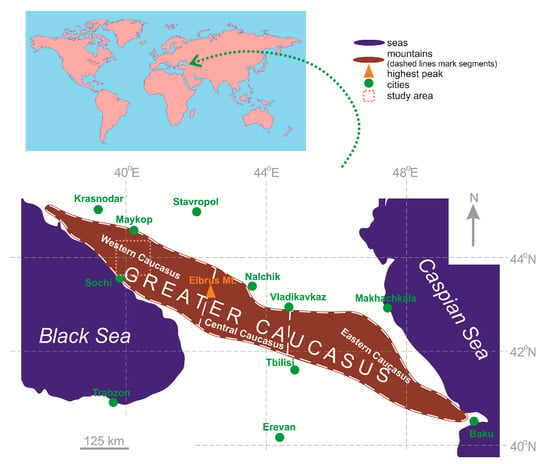
Figure 1.
Geographical location of the study area.
The Greater Caucasus is a Cenozoic orogen, which grew in place of the island arcs and the back-arc basins that evolved in the Jurassic–Paleogene and were embraced by the large Caucasian Sea [4,5,10,11,12,13,14]. The Western Caucasus is distinguished by the dominance of Jurassic–Paleogene deposits, whereas the distribution of pre-Jurassic crystalline and sedimentary rocks is subordinate and limited to only narrow zones and blocks. Geological peculiarities of the study area, i.e., the central Western Caucasus, were outlined particularly by Guo et al. [8], Kolodyazhny et al. [11], and Korsakov et al. [15]. This area is dominated by Lower–Middle Jurassic sandstones and shales and Upper Jurassic carbonates (Figure 2). Cretaceous and Cenozoic deposits of different composition are found on the peripheries. Pre-Mesozoic crystalline rocks, including Precambrian metamorphics and Late Paleozoic granitoids, Paleozoic sedimentary rocks, including Permian molassic complexes, and Triassic carbonates and siliciclastics crop out locally (Figure 2). The thicknesses of some (if not many) sedimentary units are known only very approximately. The knowledge of Kimmeridgian–Hauterivian deposits, which are the focus of the present work, is presented below.
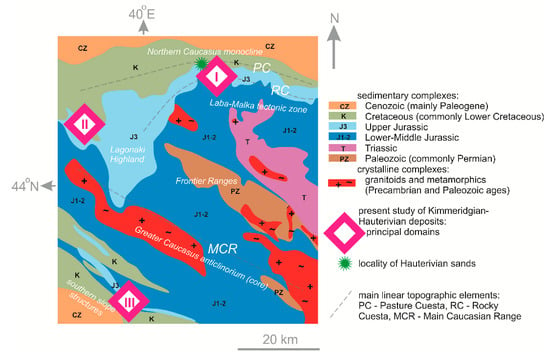
Figure 2.
Simplified geological scheme of the study area (strongly adapted from [8]).
Tectonically, the study area is highly complex [11]. It represents a kind of asymmetrical, southward-trending anticlinorium. Its widely exposed core is made of thick and intensively folded pre-Upper Jurassic complexes (mainly Lower–Middle Jurassic siliciclastics and some older rocks), whereas thinner and significantly less distorted Upper Jurassic–Cenozoic deposits represent its peripheries (Figure 3). The degree of deformation is higher in the axial zone, and it is also higher in the southern half of the area relative to its northern half. Indeed, there are numerous faults [8,11,15], but their exact geometry, nature, and relative position in the fold-thrust belt are yet to be well understood.
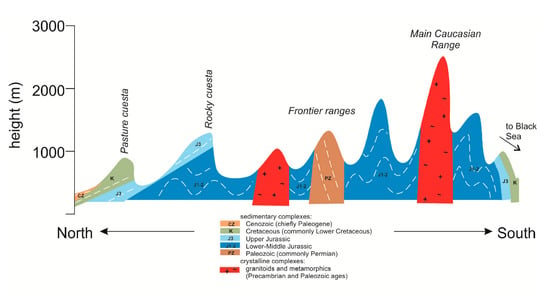
Figure 3.
An idealized cross-section of the study area. White dashed lines mark distortion of sedimentary rocks.
The geological history of the Western Caucasus, including the study area, is more or less clear from the beginning of the Jurassic. In the Jurassic–Paleogene, there were reletively deep back-arc basins separated by island arcs [4], and marine sedimentation prevailed [9]. The tectonic activity was significant, and there were phases of deformation and partial/total uplift [16,17]. The growth of the orogen started in the late Cenozoic, and it has continued until nowadays [10,11,12,13,14]. Continental environments expanded in the Western Caucasus in the second half of the Cenozoic.
3. Synthesis of Literary Evidence
3.1. Key Sources and Procedures
The present synthesis aims at representing general peculiarities of Kimmeridgian–Hauterivian deposits of three principal domains (northern, western, and southern) of the study area (Figure 2). The principal sources of the knowledge of these deposits were identified (Table 1), and the relevant information from them was extracted, critically reassessed, and logically synthesized. This information included lines of evidence of the spatial distribution and the stratigraphic relationships of more or less homogeneous sedimentary complexes, their lithological characteristics, and depositional environments. Significant attention to the relatively old, mid-20th-century sources was very reasonable because these works often contain unique details that facilitate large-scale generalizations.

Table 1.
Literature employed for the synthesis of the information on Kimmeridgian–Hauterivian deposits of the study area.
Generalized lithostratigraphical columns were constructed for each domain with the information summarized from the sources (Table 1). Field observations made in the northwestern and western domains facilitated the solution of this task. Depositional environments were indicated on the basis of the interpretations from the same sources. The present paper does not pay attention to the biostratigraphical aspects of Kimmeridgian–Hauterivian deposits of the study area, but the considered sources (Table 1) demonstrate the appropriate biostratigraphical foundation. Despite the apparent simplicity, this synthesis required multiple reconsiderations of the information published in the literature. Without such a synthesis, it would be highly challenging (if possible) to make judgments of the sea–land interplay in the central Western Caucasus at the Jurassic–Cretaceous transition. One should note that Kimmeridgian–Hauterivian deposits crop out in the peripheral domains of the study area, whereas its central and eastern parts (a kind of core) lack rocks younger than the Middle Jurassic (Figure 2). This is why attention was also paid to peculiarities (e.g., lateral thickness changes), which can potentially indicate whether some deposits existed, but were later eroded in the core of the central Western Caucasus.
3.2. Generalized Vision of Kimmeridgian–Hauterivian Deposits
In the study area, Kimmeridgian–Hauterivian deposits crop out as narrow stripes and spots. In the northern domain, their exposures stretch from the west to the east, i.e., along the slopes of the Pasture and Rocky cuestas. In the western domain, they are found in particular localities around the Lagonaki Highland. In the southern domain, these deposits occur sporadically. The synthesis demonstrates that Kimmeridgian–Hauterivian deposits are highly heterogeneous within the study area (Figure 4). They differ lithologically and regarding their depositional environments. The highest diversity of sedimentary rocks and depositional environments is established in the north. It should be stressed that each considered package of Kimmeridgian–Hauterivian deposits accumulated mainly in the entire domain (with a few exceptions mentioned below).
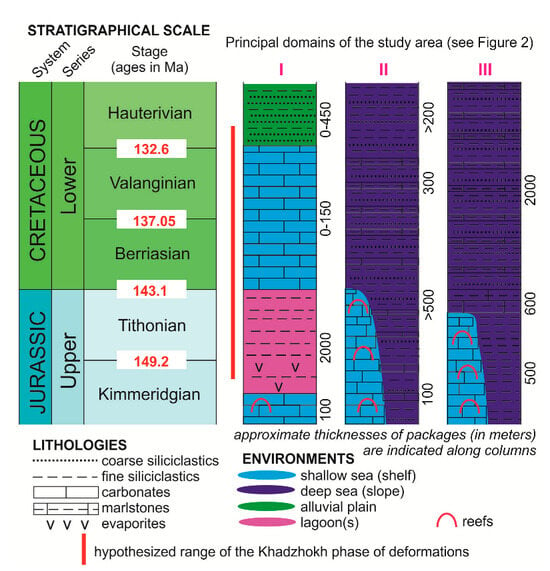
Figure 4.
Synthetic Kimmeridgian–Hauterivian lithostratigraphy of the study area (numerical ages follow the recommendations of the International Commission on Stratigraphy [27]; unconformities are not shown due to the debated nature of the related surfaces [11] or unclear position; the hypothesized range of the Khadzhokh phase of deformations after [23]).
The principal sedimentary packages and their dominant lithologies and facies are shown in Figure 4. The informal term “package” is preferred in this paper to avoid confusion with formations or other formal lithostratigraphic units. Several additional comments are required to clarify the architecture of Kimmeridgian–Hauterivian deposits in the study area. First, Berriasian–Valanginian carbonates only occur in the western part of the northern domain, and their thickness decreases until they totally disappear in its other parts. Second, the thickness of Hauterivian siliciclastics decreases in the eastern direction, and these siliciclastics overlay transgressively Berriasian–Valanginian carbonates. Third, reefal carbonates formed much longer in the western and southern domains than in the northern domain (Figure 4). It should be stressed that reefal carbonates of the western domain bordered an early Kimmeridgian carbonate platform and late Kimmeridgian–Tithonian evaporites and variegated siliciclastics of the northern domain. Fourth, the thickness of Tithonian variegated siliciclastics decreases in the southern direction, but small remnants of these deposits in the Lagonaki Highland imply their previous distribution south of the northern domain, i.e., in the central part of the study area where post-Middle Jurassic deposits do not exist presently. Fifth, it appears that Hauterivian deposits were distributed wider than Berriasian–Valanginian deposits in the southern domain.
Depositional peculiarities of Kimmeridgian–Hauterivian deposits of the central Western Caucasus can be characterized on the basis of the generalized synthesis of the published knowledge (Figure 4). The majority of the considered sedimentary packages are marine in origin (Figure 4). Although their peculiarities can be useful (chiefly indirectly) to assume the existence of land masses on neighboring plots, more important are lines of evidence from terrestrial and transitional (lagoonal) packages. These are generally very uncommon for Mesozoic deposits of the central Western Caucasus (and even the entire Greater Caucasus), but they are present in the northern domain of the study area (Figure 4). The first of them includes late Kimmeridgian–Tithonian evaporites and variegated siliciclastics, which accumulated in arid climatic conditions. The analysis of the dominant rocks, namely siltstones, implied that their composition includes up to 20% of feldspars, detrital grains of which originated from pre-Mesozoic granitoid massifs [26] exposed in the central domain of the study area (Figure 2). Moreover, it is very likely that detrital quartz grains constituting about half of these siltstones [26] were recycled from thick Permian siliciclastic beds cropping out locally (Figure 2). This can be understood as a delivery of sedimentary material from a denudated land to lagoons on its periphery during the late Kimmeridgian–Tithonian. Lagoons with brackish water are evidenced by the presence of gypsum grains and layers. The second terrestrial package includes Hauterivian sandstones (Figure 4). The previous studies established that they accumulated on an alluvial plain, with a river that flowed to the northwest [5,23]. Compositional peculiarities of these Hauterivian sandstones were examined in the case study (see below).
4. Case Study: Composition of Hauterivian Sandstones
4.1. Material and Procedures
Hauterivian poorly lithified sandstones cropping out in the northern domain of the study area provide important insights into the sea–land interplay in the central Western Caucasus. These deposits were considered by Ruban [5] and Mikhailenko and Ruban [23], but their composition was not studied in detail. To fill this gap, Hauterivian sandstones were sampled at three stratigraphical levels in an abandoned quarry, which seems to be the most representative locality of these deposits. The rocks demonstrate only weak mechanical cementation, and their samples look like those of sands. The sampled levels characterize the lower member of the Hauterivian siliciclastic package, and the lower and upper parts of its upper member. These levels were chosen on the basis of the initial examination of sandstones, which permitted outlining three homogeneous units. If so, one sample from each unit seems to be sufficient for further analyses. The latter were carried out in the laboratories of the Institute of Geology and Petroleum Technologies of the Kazan Federal University (Kazan, Russia).
All samples were washed out for separating light and heavy fractions (the latter constitute < 0.5%). Morphological peculiarities of grains and their mineralogical compositions were established with observations under a stereomicroscope. Raman spectroscopy was used because this approach enhances the analysis of heavy minerals in sandstones [28,29,30]. Mineral composition of the heavy fraction of each sample was carried out with a Raman spectrometer inVia Qontor (Renishaw, UK) enhanced with optimal microscope Leica DM2700 M (Leica Microsystems, Germany) and Nd:YAG laser with a wavelength of 532 nm. The samples of the heavy fraction were fixed in epoxy resin checkers and placed on the object stage of the device. Raman spectra were recorded using the grid mapping method (the number of grid nodes averaged 1000). Recording was carried out in the range of 73–1836 cm−1. A single-crystal silicon standard was used to calibrate the spectral lines and the position of the laser beam. The resulting spectra were divided into clusters corresponding to a particular mineral phase. Within each cluster, the spectra were identified by comparing them with the spectra from the Renishaw reference libraries. Based on the data obtained, the mineral composition of the heavy fraction was established quantitatively.
4.2. Results
In their representative locality, Hauterivian deposits are sandstones that can be divided into two rather homogeneous members (Figure 5). The lower member has a visible thickness of ~20 m, and it is distinguished by cross-bedding. The upper member has a visible thickness of ~10 m, and it is distinguished by subparallel bedding. The former accumulated in an ancient channel, whereas the latter represents deltaic environments [23]. These sandstones are so poorly cemented that they look like modern sands.
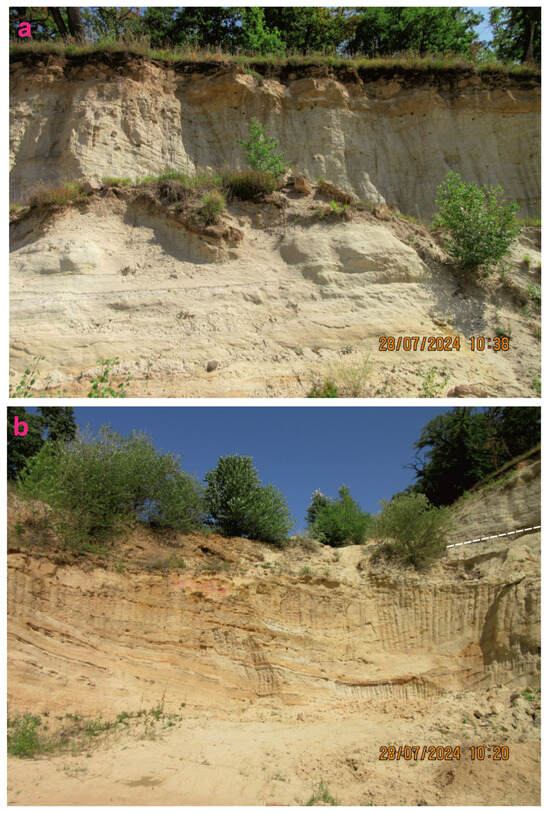
Figure 5.
Hauterivian sandstones at the main locality in the northern domain of the study area: (a) upper member with subparallel bedding, and (b) lower member with cross-bedding (white dashed line indicates the contact between the lower and upper members).
The investigations carried out imply that the sandstones are dominated by the light fraction (>99.5%) (Figure 6), with grains of quartz (70–95%), feldspars (3–10%), and detrital rock fragments (up to 15%). Grains are mainly very fine and fine sand, although coarse grains are also present. Roundness differs: quartz grains are angular and subangular, feldspar grains are subangular, and detrital rock fragments are often subrounded and rounded. Quartz is commonly transparent or white. Feldspars exhibit secondary alterations due to weathering. Detrital rock fragments represent, in particular, limestones, black marbles, and serpentinites. The samples taken from the different stratigraphical levels are rather similar. The greatest similarity is established between the sandstones of the lower member and the upper part of the upper member. They are distinguished by the very high content of quartz (up to 95%) and the relatively low quantity of feldspars (<5%). However, the quantity of detrital rock fragments is lower in the lower member. The lower part of the upper member differs by the lower amount of quartz grains (80% or less) and the higher amount of feldspar grains (up to 10%). The amount of detrital rock fragments is comparable to that in the upper part of this member. The noted differences can be explained by the changes in land erosion. The latter started when the lower member was deposited. Then, erosion reached deeper layers (pre-Mesozoic complexes), which resulted in the higher amount of feldspars and detrital rock fragments. This continued during the deposition of the upper part of the upper member, but the erosion profile became smoother and the strength of erosion reduced.
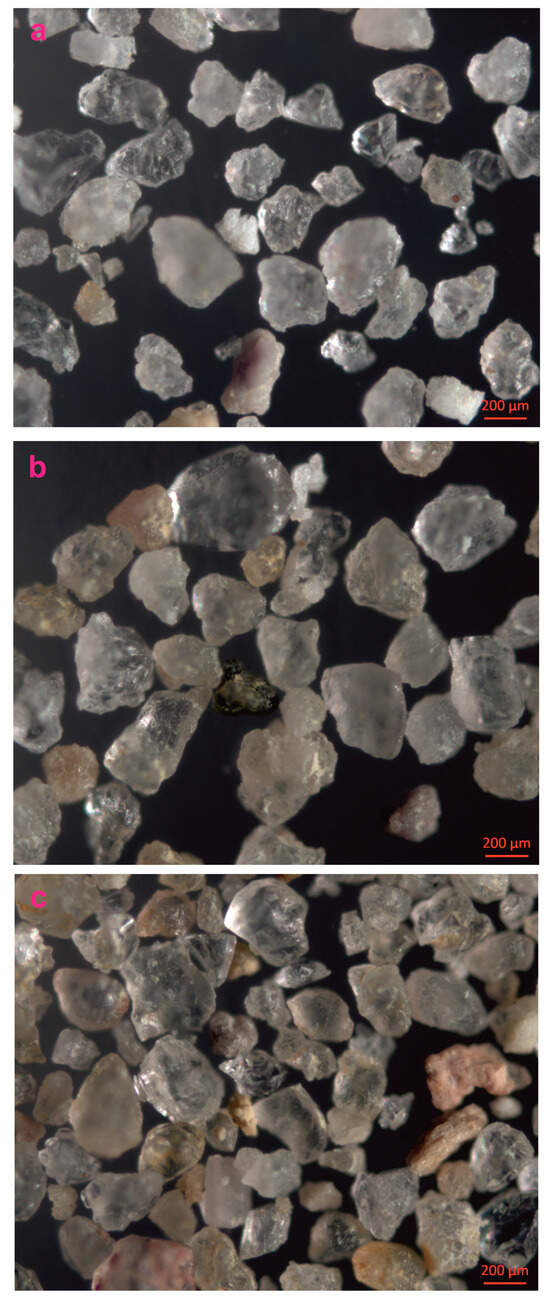
Figure 6.
Light fraction of Hauterivian sandstones at the main locality in the northern domain of the study area: (a) upper part of the upper member, (b) lower part of the upper member, and (c) lower member.
The analysis of the heavy fraction of the same samples of Hauterivian sandstones indicates the presence of grains derived from igneous and metamorphic rocks (Table 2, Figure 7). Indeed, some of them could be recycled from Jurassic sedimentary complexes; such recycling is proven by the presence of siderite, which occurs in significant amounts in Lower–Middle Jurassic shales. A significantly higher amount of siderite in only the lower member of the Hauterivian package (Table 2) confirms the above-proposed idea that this member was formed when Jurassic sedimentary complexes were eroded, whereas older (also crystalline) rocks were eroded later. An increase in the content of some heavy minerals in the upper member relative to the lower member (Table 2) means that many grains were derived from the parent rocks and not recycled from Jurassic deposits.

Table 2.
Heavy fraction composition of Hauterivian sandstones from the sampled section (established with Raman spectroscopy).

Figure 7.
Selected mineral grains from the heavy fraction of Hauterivian sandstones at the main locality in the northern domain of the study area: (a) tourmaline, (b) zircon, (c) rutile, and (d) garnet.
Although Hauterivian terrestrial deposits are not distributed widely in the study area (their deposits are registered only locally in the northern domain), their analysis implies that they mark the existence of a denudated land mass.
5. Discussion
5.1. Tentative Paleogeographic Model
The generalized synthesis (Figure 4) and the established composition of Hauterivian sandstones permitted the proposal of a paleogeographical model for the central Western Caucasus during the Kimmeridgian–Tithonian. Four main intervals were the early Kimmeridgian, the late Kimmeridgian–Tithonian, the Berriasian–Valanginian, and the Hauterivian. Tentative paleogeographical reconstructions were made for each of them (Figure 8), and they are explained below.
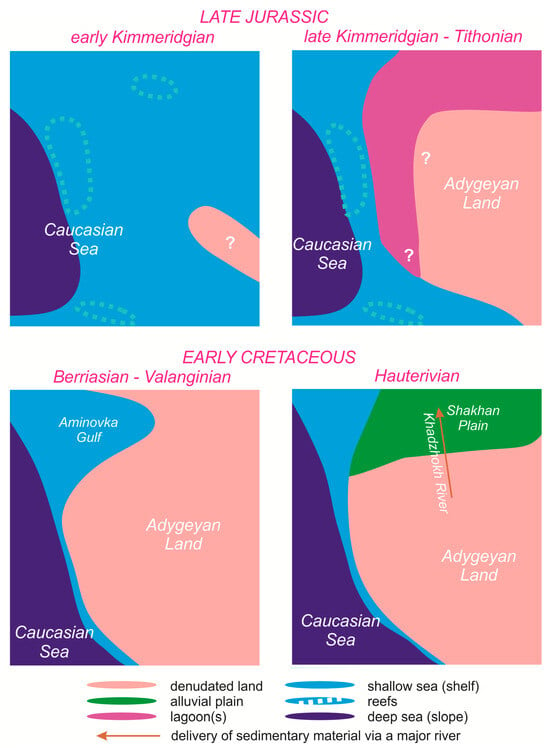
Figure 8.
Paleogeographical reconstruction of the study area during the Kimmeridgian–Hauterivian. The shown area corresponds exactly to that shown in Figure 2. The sign “?” marks uncertain interpretations (see text for more details).
In the early Kimmeridgian, a significant part of the study area was covered by a shallow Caucasian Sea (Figure 8), where a large carbonate platform existed. Massive reefs marked its periphery, and this platform was a rimmed shelf. A deep basin was located in the western part of the area. A small land mass was hypothesized following the proposal by Guo et al. [8]. The situation changed dramatically in the late Kimmeridgian–Tithonian, when variegated siliciclastics with evaporites formed between the reefs in the west and a growing land in the east (Figure 8). The latter can be called the Adygeyan land following Drushits and Mikhailova [7]. Denudation of this land contributed to the accumulation of siltstones. This reconstruction faces uncertainty linked to the impossibility of determining the true extent of the package with variegated siliciclastics in the central part of the area. It is also important to note the genetic links between reefs and the deposition of evaporites and sabkha in the Greater Caucasus during the Late Jurassic [31].
The local paleogeography transformed significantly at the beginning of the Cretaceous (Figure 8). On the one hand, the land expanded, as this can be recorded by the scarcity of Berriasian–Valanginian deposits. Their lateral disappearance is established locally and, in particular, is well documented in the northern domain [15]. On the other hand, the sea ingressed in the northwestern part of the central Western Caucasus, where it formed a small gulf with prevailing carbonate deposition (this can be called the Aminovka Gulf after the small Aminovka River, where the related deposits crop out). In the Hauterivian, the above-mentioned gulf disappeared, and its place was occupied by an alluvial plain to be called the Shakhan Plain after the present-day mountain with sandstone exposures (Figure 8). This plain was wider than the gulf and extended eastward. However, the thickness of Hauterivian alluvial deposits decreases in the same direction, and these deposits almost disappear at the northeastern edge of the central Western Caucasus [15]. A river that formed this plain flowed from the interior of the denudated land to the northwest [5], and it is proposed to be called the Khadzhokh River. Generally, the Hauterivian land shrank slightly in size, and deep-marine environments prevailed in the western and southern domains.
5.2. Possible Factors of Paleogeographical Changes
The proposed scenario of the sea–land interplay in the central Western Caucasus (Figure 8) requires proper explanation. Three factors should be considered, namely eustasy, changes in the accommodation space, and regional tectonic activity. Eustasy should be ruled out because of two reasons. First, Haq [32] reconstructed a very high position of the global sea level at the Kimmeridgian–Tithonian transition, and this level did not drop significantly until the end of the Jurassic. Second, there was a significant eustatic fall in the Valanginian followed by a rapid rise in the Hauterivian [33]. All these features do not coincide with shoreline shifts registered in the study area. Moreover, even assuming any long-term eustatic control of the local paleogeographical changes, this cannot explain, for instance, the Berriasian–Valanginian ingression in the northern domain instead of the contemporary regression in the southern domain (Figure 6). As for the accommodation space, its changes can be considered in two cases. First, it was possible that filling lagoons between the land mass and the narrow carbonate platform with reefs during the late Kimmeridgian–Tithonian created a new portion of land in the central domain at the beginning of the Cretaceous. Second, filling the shallow gulf in the Valanginian could contribute to the advance of the alluvial plain.
The regional tectonic activity seems to be the most plausible, almost universal explanation. Structural observations made by Mikhailenko and Ruban [23] led to the proposal of the long-term Khadzhokh phase of deformations across the Jurassic–Cretaceous transition (Figure 4). Hiatuses, erosional surfaces, and disconformities noted in the considered sources (Table 1) prove this idea. The mechanism of this tectonic activity is unknown, and it could be related to either regional compression or fault activity. Kolodyazhny et al. [11] argued that the northern domain (at least) of the study area underwent significant reorganization in the Quaternary when large and thin slices of sedimentary rocks slid gravitationally on the northern slope of the rising, swell-shaped orogen. Principally, this means that this orogen is very young (see also discussions below). Tectonic–gravitational detachments were subparallel to surfaces separating Kimmeridgian–Hauterivian sedimentary packages. Nonetheless, the paleogeographical changes reported in the present work (Figure 8) can be explained only with some tectonic activity in the Kimmeridgian–Hauterivian. The proposal by Kolodyazhny et al. [11] should not be understood as an alternative to the idea of the Khadzhokh phase of deformations, and they seem to be compatible: e.g., late Cenozoic detachments could inherit disconformities resulting from the tectonic activity at the Jurassic–Cretaceous transition.
5.3. Paleogeographical Hypothesis for Further Verification
The outcomes of the present study may have broader implications for the understanding of the geological history of the entire Greater Caucasus. Commonly, the latter is thought to be a Mesozoic marine basin that was inverted and became mountains in the second half of the Cenozoic [34]. This means that the Lower Cretaceous and older rocks became permanently exposed only in the Neogene–Quaternary due to deep erosion of the rising orogen. This traditional scenario (Table 2) was proven by modern studies, but west of the study area [35,36].
The present work stresses the existence of a significant landmass in the central Western Caucasus during the late Kimmeridgian–Hauterivian (Figure 6). The previous regional reconstructions [9] permit it to be treated as an island. Thus, the information from the central Western Caucasus contributes to the very scarce international knowledge of Mesozoic islands [37,38,39]. Moreover, the preliminary analysis of the published literature (Table 1) implies that it can be hypothesized that this land existed later, until the late Cenozoic orogeny (Table 3). Indeed, the size of the land varied. This hypothetical scenario with a very long-term existence of the land in this part of the Greater Caucasus needs further investigation, but, if valid, it stresses the outstanding role of the Late Jurassic paleogeographical changes and the related tectonic mechanisms in the regional geological development.

Table 3.
Scenarios of the Mesozoic–Cenozoic geological evolution of the central Western Caucasus.
Earlier, the uplift of the Greater Caucasus and, particularly, the Western Caucasus was thought to have occurred in the Cenozoic, and the proposed ages range between the Eocene and the Pliocene [10,40,41,42,43]. Recent investigations in the Western Caucasus and adjacent regions showed that the orogeny took place only in the Quaternary [11,44]. It is unclear whether the time was enough for such deep erosion and wide exposure of pre-Upper Jurassic rocks (Figure 2) if they remained covered by younger deposits. The hypothetical scenario (Table 3) provides a reasonable explanation, i.e., a gradual denudation of the long-existed landmass. The results of the present study imply that the erosion reached pre-Jurassic complexes already at the Jurassic–Cretaceous transition, and the land has only been resculptured since this time. It is known that this land was low and plain-like in the Miocene [45]. The rapid Quaternary uplift [11] strengthened erosion and, thus, increased the exposure of pre-Upper Jurassic rocks.
6. Conclusions
The analysis of the literature and original information on the Kimmeridgian–Hauterivian deposits of the central Western Caucasus permits three principal conclusions, as follows. First, these deposits are distributed in the northern, western, and southern domains of the study area. Second, the case study of Hauterivian sandstones implies sediment delivery from the denudated land to the shore. Third, a relatively large landmass (possible island) existed in the central Western Caucasus in the late Kimmeridgian–Hauterivian, and its configuration was controlled by tectonics.
Two principal perspectives for further investigation are as follows. First, it is necessary to carry out detailed examination of the composition of Upper Jurassic–Lower Cretaceous marine and non-marine deposits from different localities of the central Western Caucasus to reconstruct the provenance of their clastic constituents. Second, attention should be paid to the spatial distribution, lateral thickness variation, and depositional environments of Barremian–Maastrichtian rocks cropping out in the study area, which is necessary to collect additional evidence supporting (or not) the existence of the land throughout the Cretaceous.
Author Contributions
Conceptualization, D.A.R.; methodology, D.A.R., S.O.Z., K.I.N., and R.N.M.; investigation, D.A.R., S.O.Z., K.I.N., and R.N.M.; writing—original draft preparation, D.A.R., S.O.Z., K.I.N., and R.N.M.; project administration, D.A.R. and S.O.Z. All authors have read and agreed to the published version of the manuscript.
Funding
This research received no external funding.
Data Availability Statement
All data are provided directly in the main paper.
Acknowledgments
D.A.R. thanks N.V. Ruban for support during field studies.
Conflicts of Interest
The authors declare no conflicts of interest.
References
- Barrier, E.; Vrielynck, B.; Brouillet, J.F.; Brunet, M.F. Paleotectonic Reconstruction of the Central Tethyan Realm. In Tectono-Sedimentary-Palinspastic Maps from Late Permian to Pliocene. Atlas of 20 Maps; CGMW/CCGM: Paris, France, 2018. [Google Scholar]
- Golonka, J. Plate tectonic evolution of the southern margin of Eurasia in the Mesozoic and Cenozoic. Tectonophysics 2004, 381, 235–273. [Google Scholar] [CrossRef]
- Scotese, C.R. An Atlas of Phanerozoic Paleogeographic Maps: The Seas Come In and the Seas Go Out. Annu. Rev. Earth Planet. Sci. 2021, 49, 679–728. [Google Scholar] [CrossRef]
- Adamia, S.; Alania, V.; Chabukiani, A.; Kutelia, Z.; Sadradze, N. Great Caucasus (Cavcasioni): A long-lived North-Tethyan back-arc basin. Turk. J. Earth Sci. 2011, 20, 611–628. [Google Scholar] [CrossRef]
- Ruban, D.A. Islands in the Caucasian Sea in Three Mesozoic Time Slices: Novel Dimension of Geoheritage and Geotourism. J. Mar. Sci. Eng. 2022, 10, 1330. [Google Scholar] [CrossRef]
- Baraboshkin, E.Y.; Alekseev, A.S.; Kopaevich, L.F. Cretaceous palaeogeography of the North-Eastern Peri-Tethys. Palaeogeogr. Palaeoclimatol. Palaeoecol. 2003, 196, 177–208. [Google Scholar] [CrossRef]
- Drushits, V.V.; Mikhailova, I.A. Biostratigraphy of the Lower Cretaceous of the Northern Caucasus; MGU: Moscow, Russia, 1966. (In Russian) [Google Scholar]
- Guo, L.; Vincent, S.J.; Lavrishchev, V. Upper Jurassic Reefs from the Russian Western Caucasus: Implications for the Eastern Black Sea. Turk. J. Earth Sci. 2011, 20, 629–653. [Google Scholar] [CrossRef]
- Yasamanov, N.A. Landscape-Climatic Conditions of the Jurassic, the Cretaceous and the Paleogene of the South of the USSR; Nedra: Moscow, Russia, 1978. (In Russian) [Google Scholar]
- Forte, A.M.; Gutterman, K.R.; van Soest, M.C.; Gallagher, K. Building a Young Mountain Range: Insight Into the Growth of the Greater Caucasus Mountains From Detrital Zircon (U-Th)/He Thermochronology and 10Be Erosion Rates. Tectonics 2022, 41, e2021TC006900. [Google Scholar] [CrossRef]
- Kolodyazhny, S.Y.; Kuznetsov, N.B.; Makhinya, E.I.; Shalaeva, E.A.; Dantsova, K.I.; Romanyuk, T.V.; Antipov, M.P.; Parfenov, G.E. Tectono-Gravitational Detachments in the Alpine Cover of the Northern Slope of the Greater Caucasus and Western Pre-Caucasus Basin (Adygean Segment). Geotectonics 2024, 58, 611–638. [Google Scholar] [CrossRef]
- Makeev, V.M.; Revazov, M.O.; Pikulik, E.A.; Fikri, E.A. Structures of the alpine orogenesis southern slope of the Greater Caucasus Western segment related to the ensuring safety of engineering sites. Geol. I Geofiz. Yuga Ross. 2024, 14, 39–53. [Google Scholar]
- Vasey, D.A.; Garcia, L.; Cowgill, E.; Trexler, C.C.; Godoladze, T. Episodic evolution of a protracted convergent margin revealed by detrital zircon geochronology in the Greater Caucasus. Basin Res. 2024, 36, e12825. [Google Scholar] [CrossRef]
- Zelenin, E.; Garipova, S. Geological History and Active Tectonics of European Russia. Dokl. Earth Sci. 2024, 519, S7–S13. [Google Scholar] [CrossRef]
- Korsakov, S.G.; Semenukha, I.N.; Beluzhenko, E.V.; Chernykh, V.I.; Tuzikov, G.R.; Grekov, I.I.; Tokarev, V.N.; Derkacheva, M.G.; Sokolov, V.V. State Geological Map of Russian Federation of the Scale 1:200,000. Caucasian series. Maykop. Explanatory note; Russian Geological Research Institute: Saint Petersburg, Russia, 2004. (In Russian) [Google Scholar]
- Giorgobiani, T.V. Conditions of formation of the Alpine folded system of the Greater Caucasus and unique features of it’s structure. Geol. I Geofiz. Yuga Ross. 2019, 9, 43–57. [Google Scholar]
- Kushcheva, Y.V.; Latysheva, I.V.; Golovin, D.I.; Gavrilov, Y.O. Textural-structural, mineralogical, isotopic, and age characteristics of Jurassic terrigenous rocks of the northwestern Caucasus (the Belaya River section). Lithol. Miner. Resour. 2007, 43, 257–267. [Google Scholar] [CrossRef]
- Andreev, V.M. Stratigraphic scheme of the Caucasus Black Sea coast. In Geology and Biodiversity of the Mesozoic–Cenozoic Deposits of the Russian South; Pinchuk, T.N., Ed.; Tetis: Goryachiy Klyuch, Russia, 2015; pp. 4–10. (In Russian) [Google Scholar]
- Goryacheva, A.A.; Zorina, S.O.; Ruban, D.A. New palynological data from the Upper Jurassic deposits of the Western Caucasus. Vestn. Udmurt. universiteta. Ser. Biologija. Nauk. O Zemle 2022, 4, 449–459. (In Russian) [Google Scholar] [CrossRef]
- Egoyan, V.L. Tectonic development of the Western Ciscaucasus and the North-Western Caucasis in the Cretaceous Period. In Osobennosti Geologicheskogo Stroeniya i Neftegazonosnosti Predkavka’ya i Sopredel’nykh Rayonov; Nauka: Moscow, Russia, 1965; pp. 112–130. (In Russian) [Google Scholar]
- Egoyan, V.L.; Tkachuk, G.A. To the stratigraphy of the Hauterivian of the Northern Caucasus. Tr. KFVNIInetf’ 1965, 16, 244–285. (In Russian) [Google Scholar]
- Luppov, N.P. Lower Cretaceous Deposits of the North-Western Caucasus and Their Fauna; Gostoptekhizdat: Moscow, Russia, 1952. (In Russian) [Google Scholar]
- Mikhailenko, A.V.; Ruban, D.A. Geosites of Northern Mountainous Adygeya (Southwestern Russia): A Novel Vision. Geosciences 2024, 14, 249. [Google Scholar] [CrossRef]
- Mordvilko, T.N. Lower Cretaceous Deposits of the Morthern Caucasus and the Ciscaucasus; Izdatel’stvo Akademii nauk SSSR: Moscow, Russia, 1960. (In Russian) [Google Scholar]
- Rostovtsev, K.O.; Agaev, V.B.; Azarian, N.R.; Babaev, R.G.; Besnosov, N.V.; Hassanov, N.A.; Zesashvili, V.I.; Lomize, M.G.; Paitschadze, T.A.; Panov, D.I.; et al. Jurassic of the Caucasus; Nauka: St. Petersburg, Russia, 1992. (In Russian) [Google Scholar]
- Ruban, D.A.; Mikhailenko, A.V.; Zorina, S.O.; Yashalova, N.N. Geoheritage Resource of a Small Town: Evidence from Southwestern Russia. Geoheritage 2021, 13, 82. [Google Scholar] [CrossRef]
- International Commission on Stratigraphy. Available online: https://stratigraphy.org/ (accessed on 11 June 2025).
- Chavez, I.; Pe-Piper, G.; Piper, D.J.W.; Andrew MacRae, R. Late Mesozoic sediment provenance on Georges Bank: Enlargement of river drainages to the Atlantic Ocean in the Late Jurassic–Early Cretaceous. AAPG Bull. 2019, 103, 1321–1350. [Google Scholar] [CrossRef]
- Feil, S.; von Eynatten, H.; Dunkl, I.; Schönig, J.; Lünsdorf, N.K. Inherited Grain-Size Distributions: Effect on Heavy-Mineral Assemblages in Modern and Ancient Sediments. J. Geophys. Res. Earth Surf. 2024, 129, e2023JF007356. [Google Scholar] [CrossRef]
- Ravidà, D.C.G.; Caracciolo, L.; Heins, W.A.; Stollhofen, H. Towards an improved discrimination and correlation of Permian-Lower Triassic sediments in Central Europe: A chemostratigraphic approach. Sediment. Geol. 2023, 452, 106408. [Google Scholar] [CrossRef]
- Boiko, N.I. Gold mineralization in Upper Jurassic reefogenic rocks of the Northern Caucasus. Dokl. Earth Sci. 2000, 370, 37–38. [Google Scholar]
- Haq, B.U. Jurassic Sea-Level Variations: A Reappraisal. GSA Today 2018, 28, 4–10. [Google Scholar] [CrossRef]
- Haq, B.U. Cretaceous eustasy revisited. Glob. Planet. Chang. 2014, 113, 44–58. [Google Scholar] [CrossRef]
- Adamia, S.; Zakariadze, G.; Chkhotua, T.; Sadradze, N.; Tsereteli, N.; Chabukiani, A.; Gventsadze, A. Geology of the Caucasus: A Review. Turk. J. Earth Sci. 2011, 20, 489–544. [Google Scholar] [CrossRef]
- Kuznetsov, N.B.; Romanyuk, T.V.; Shatsillo, A.V.; Latysheva, I.V.; Fedyukin, I.V.; Strashko, A.V.; Novikova, A.S.; Shcherbinina, E.A.; Drazdova, A.V.; Makhinya, E.I.; et al. Cretaceous–Eocene Flysch of the Sochi Synclinorium (Western Caucasus): Sources of Clastic Material Based on the Results of U–Th–Pb Isotope Dating of Detrital Zircons. Lithol. Miner. Resour. 2024, 59, 47–69. [Google Scholar] [CrossRef]
- Nikishin, A.M.; Ershov, A.V.; Nikishin, V.A. Geological history of Western Caucasus and adjacent foredeeps based on analysis of the regional balanced section. Dokl. Earth Sci. 2010, 430, 155–157. [Google Scholar] [CrossRef]
- El-Yamani, M.S.; John, C.M.; Bell, R. Mechanism of island dolostones formation in the Cretaceous calcitic ocean: Insights from the Mid-Pacific Guyots. Mar. Pet. Geol. 2024, 163, 106741. [Google Scholar] [CrossRef]
- Johnson, M.E. Paleoislands in the stream: Paleogeography and expected circulation patterns. Geobios 2002, 35, 96–106. [Google Scholar] [CrossRef]
- Robles-Salcedo, R.; Vicedo, V. Palaeoenvironments of an Upper Cretaceous mixed carbonate-siliciclastic shelf of the external Prebetic domain (Valencia, SE Spain). Facies 2023, 69, 13. [Google Scholar] [CrossRef]
- Khain, V.E. On the role of the Transcaucasian transverse uplift in preorogenic alpine evolution of the Greater Caucasus. Dokl. Earth Sci. 2009, 426, 532–533. [Google Scholar] [CrossRef]
- Saintot, A.; Brunet, M.-F.; Yakovlev, F.; Sebrier, M.; Stephenson, R.; Ershov, A.; Chalot-Prat, F.; McCann, T. The Mesozoic-Cenozoic tectonic evolution of the Greater Caucasus. Geol. Soc. Mem. 2006, 32, 277–289. [Google Scholar] [CrossRef]
- Vincent, S.J.; Morton, A.C.; Carter, A.; Gibbs, S.; Barabadze, T.G. Oligocene uplift of the Western Greater Caucasus: An effect of initial Arabia-Eurasia collision. Terra Nova 2007, 19, 160–166. [Google Scholar] [CrossRef]
- Vincent, S.J.; Braham, W.; Lavrishchev, V.A.; Maynard, J.R.; Harland, M. The formation and inversion of the western Greater Caucasus Basin and the uplift of the western Greater Caucasus: Implications for the wider Black Sea region. Tectonics 2016, 35, 2948–2962. [Google Scholar] [CrossRef]
- Kuznetsov, N.B.; Latysheva, I.V.; Novikova, A.S.; Dubenskiy, A.S.; Erofeeva, K.G.; Sheshukov, V.S.; Dantsova, K.I.; Khafizov, S.F.; Romanyuk, T.V.; Fedyukin, I.V. To the question of the tectonic type of the Western-Kuban trough and the time of uplift of the western segment of the Greater Caucasus orogen. Neft. Khozyaystvo Oil Ind. 2024, 10, 58–63. [Google Scholar]
- Trikhunkov, Y.I.; Bachmanov, D.M.; Tesakov, A.S.; Titov, V.V.; Lomov, V.S.; Sokolov, S.A.; Latyshev, A.V.; Simakova, A.N.; Syromyatnikova, E.V.; Celik, H.; et al. Upper Pliocene–Lower Pleistocene Upper Molasse Belorechensk Formation of Western Ciscaucasia in Context of Regional Neotectonics and Paleogeography. Stratigr. Geol. Correl. 2024, 32, 348–373. [Google Scholar] [CrossRef]
Disclaimer/Publisher’s Note: The statements, opinions and data contained in all publications are solely those of the individual author(s) and contributor(s) and not of MDPI and/or the editor(s). MDPI and/or the editor(s) disclaim responsibility for any injury to people or property resulting from any ideas, methods, instructions or products referred to in the content. |
© 2025 by the authors. Licensee MDPI, Basel, Switzerland. This article is an open access article distributed under the terms and conditions of the Creative Commons Attribution (CC BY) license (https://creativecommons.org/licenses/by/4.0/).